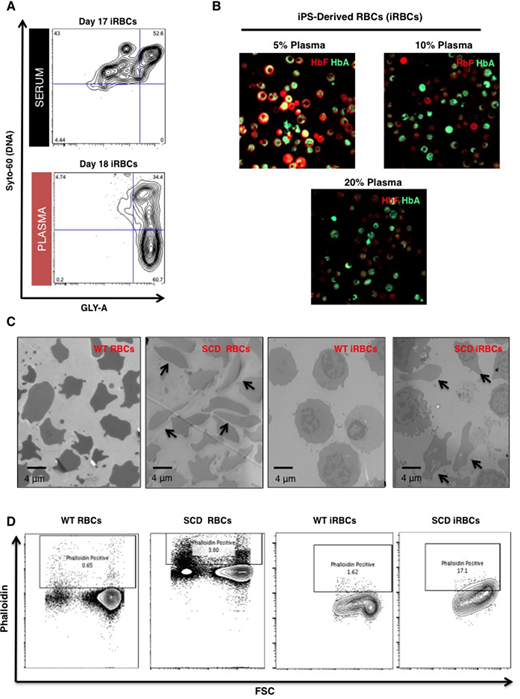Abstract
Human induced pluripotent stem cells (hiPSCs) hold remarkable capacity for disease modeling and the development of novel therapeutic treatments for sickle cell disease (SCD). hiPSCs can theoretically produce all cell types including induced red blood cells (iRBCs). Sickle cell patients, in particular, could benefit from autologous, engineered red blood cells (RBCs). Many patients possess rare Rh phenotypes, are allo-sensitized to blood products and are at risk of iron overload from recurrent transfusions. Therefore, the generation of personalized iRBCs is attractive. Yet, in vitro iRBC production has been hampered by an inability of these cells to differentiate into terminally-mature, enucleated, beta globin-expressing RBCs. Here, we describe updated strategies to improve in vitro production of iRBCs. hiPSCs from sickle cell patients as well as those with normal hemoglobin were differentiated into hematopoietic stem progenitor cells (HSPCs) and immortalized via the overexpression of a previously characterized set of transcription factors promoting self-renewal and multipotency under the control of a doxycycline-regulated promoter. Utilizing an in vitro protocol incorporating increasing concentrations of human plasma, HSPCs differentiated from these lines proceed through terminal erythroid differentiation, including the formation of CD71-/GlyA+/α4 integrin-/Band 3+ cells. Plasma-stimulated iRBCs achieved robust enucleation (11-60.7%) and underwent fetal to adult globin-switching. Further, nearly 21% of the enucleated iRBCs were RNA negative erythrocytes 5-8 microns in diameter. RNA sequencing analysis reveals similar transcriptional profiles between iRBCs and peripheral blood CD34+- derived cultured RBCs (cRBCs) yet distinct differences between SCD and WT iRBCs. SCA iRBCs have increased extracellular matrix organization, cell-cell adhesive properties and up-regulation of hypoxia-response genes. Heme metabolism, DNA repair, fatty acid metabolism and oxidative phosphorylation are all impaired in SCD iRBCs. Assessment of cell physiology exposes membrane damage in SCD iRBCs with increased phalloidin permeability in comparison to wild type controls. Intriguingly, SCD iRBCs co-expressing gamma and beta-globin also demonstrate sickling under hypoxic conditions. With the development of expandable source of erythroid progenitors capable of producing mature red cells, we now aim to utilize this platform for robust disease modeling and autologous cell therapy.
Heeney:Pfizer: Research Funding; Sancilio Pharmaceuticals: Consultancy, Research Funding; Astra Zeneca: Consultancy, Research Funding; Ironwood: Research Funding; Novartis: Membership on an entity's Board of Directors or advisory committees; Vertex/Crisper: Other: Data Monitoring Committee.
Author notes
Asterisk with author names denotes non-ASH members.


This feature is available to Subscribers Only
Sign In or Create an Account Close Modal